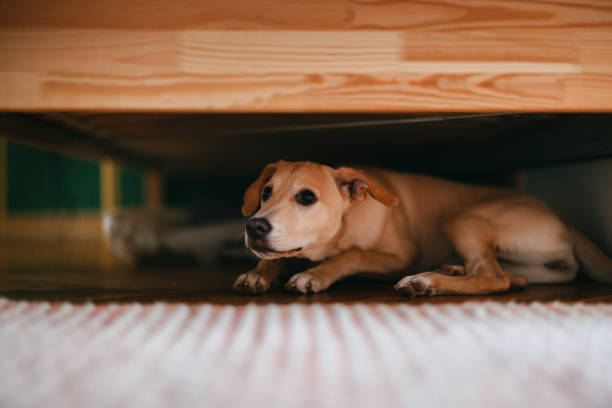
Table of Contents
Introduction
Dogs, much like humans, can also experience anxiety. Dog anxiety is a prevalent condition that affects many dogs of all ages and breeds. It leads to various behavioral and health issues if it is left untreated. Understanding dog anxiety is crucial for every pet owner. Recognizing the signs of anxiety, understanding the causes, and knowing how to treat anxiety can help improve the well-being of your pet and improve a dog’s quality of life. In this article we will learn about the signs, causes and how to treat anxiety.

Signs of dogs anxiety
Recognizing the signs of anxiety in dogs is crucial for early effective management. Identifying anxiety in dogs can be challenging, as symptoms often overlay with other behavioral issues. The signs of anxiety can be seen in various behavioral and physical changes. Here are some common signs of dogs anxiety:-
- Behavioural changes
- Dogs may bark excessively when they are anxious.
- Destructive behaviors like chewing furniture, digging holes etc. can be the sign of anxiety.
- They sometimes manifest as aggression towards people or other animals.
- They often seek hiding places when they are anxious.
- They show signs of restlessness.
- Physical symptoms
- Anxiety can lead to reduced appetite, dogs refuse to eat when they are anxious.
- Dogs may excessively lick or chew their skin or fur.
- Dogs may drop saliva uncontrollably from the mouth.
- Dogs may tremble without apparent cause.
- Other symptoms
- An anxious dog may be overly alert and react to the slightest noises.
- They avoid eye contact, it can also be a sign of anxiety.
- Their body language often indicates fear or anxiety.

Causes of dogs anxiety
Understanding the causes of dog anxiety is very important to provide effective care to the dogs. Anxiety in dogs can stem from genetic predispositions, environmental influences and specific situational triggers.
Lets understand this in detail,
- Genetic predispositions
- Certain breeds are more prone to anxiety due to their genetics. For instance, German Shepherds, labrador retrievers and Border Collies are often noted for higher tendencies toward anxiety.
- Environmental influences
- Dogs that haven’t been properly socialized may be anxious around people or other animals.
- Dogs that have been abandoned or mistreated in the past may develop anxiety.
- Dogs that have a strong attachment to their owners can become anxious when they get separated.
- Moving to a new home, arrival of a new family member, or other significant changes can cause anxiety.
- Specific situational triggers
- Unfamiliar environments and people can cause anxiety.
- Loud noises like thunderstorms, fireworks and other loud noises can also trigger anxiety.
- Some dogs associate veterinary visits and car rides with negative experiences and become anxious.

Treatment of dog anxiety
Treating dog anxiety requires a multifaceted approach that combines behavioural, Environmental management and physical activities and in severe cases, medication.
- Behavioural strategies
- Consistent training can help to build confidence and reduce anxiety.
- Exposing your dog to the anxiety trigger in a controlled way while fusing it with positive experience.
- Environmental management
- Maintain a consistent daily routine to help your dog feel secure. Activities like regular feeding, walking, and playtime can reduce anxiety.
- Provide a quiet and comfortable space where your dog can relax when they feel anxious.
- Physical activity
- Regular physical activities like daily walks, play sessions, and other forms of exercise can reduce anxiety.
- They need mental stimulation, puzzle toys and interactive games can keep them mentally stimulated.
- Medication
- In severe cases, a veterinarian may give anti-anxiety medication such as fluoxetine and clomipramine.
- Natural supplements such as CBD oil, an valerian root, as well as pheromone diffusers can also help to reduce anxiety.

Conclusion
In conclusion, Dog anxiety is a common issue that can significantly impact a dog’s life. By recognizing the signs of anxiety, understanding the causes, and knowing how to treat anxiety can help improve the well-being of your pet and improve a dog’s quality of life. Always consult with a veterinarian to develop the best plan for your pet’s specific needs. Addressing anxiety in a timely and effective manner can enhance your dog’s health and strengthen the bond between you and your dog.
Image Source: Getty Images
People also read about: Siamese Cat
















